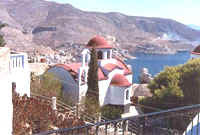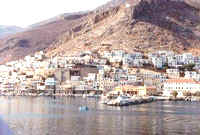 |
|
|
|
| HISTORY
The Carians, who established themselves here in prehistoric times, were succeeded by the Dorians. The island later developed a distinguished civilization, influenced by Crete and linked historically with Kos. After Roman and Byzantine periods, it was ruled by the Venetians, Knights of St. John, Turks and Italians until its union with Greece in 1947. |
|
 |
|
 |
|
SIGHTSEEING
Podia, inhabited since antiquity, became the island's capital in 1850. Up to then the principal settlement had been Horio (Village), and remnants of Byzantine and Venetian rule can still be seen there. North-west of Podia stands the Venetian castle of Chrysoheria, while ruins of earlier eras have been discovered at numerous points around the island (Damos, Vathy, etc.). |
|
| Kalymnos is famous for its caves - the Cave of the Seven Virgins (Epta Parthena), Skalies and Kefalos, as well as for the church of Christ of Jerusalem (6th c.). Apart from ancient and medieval monuments, its fertile valleys and lovely beaches, Kalymnos offers the possibility of visiting of its two neighbors: Telendos, which was united with Kalymnos until the earthquake of 535 AD; and Pserimos, with its exquisite beaches, a haven of tranquility. |
|
 |
|
| Scarcely developed for tourism, all three islands hold out a promise of picturesque and peaceful holidays. |
| |
|
 |
|
|
|